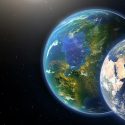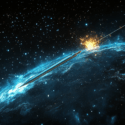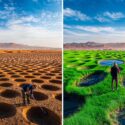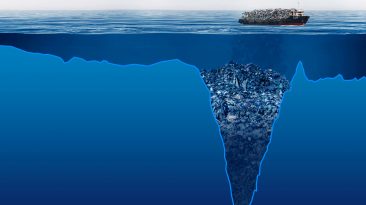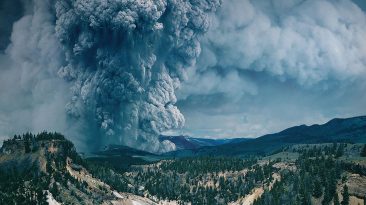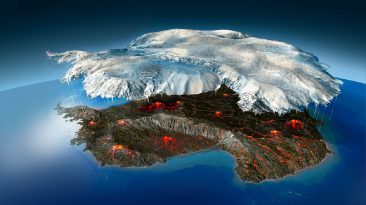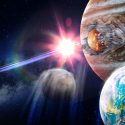Right now, wherever you are, you are spinning with our planet at hundreds of meters per second. But what if our planet started hitting the brakes until our world didn’t spin at all? Why would it be harder for you to move around? Why would some parts of the world actually benefit from this? And why could this slowdown provide you with the trip of a lifetime?
Earth’s rotation on its axis is the reason why you experience day and night over the 24 hours it takes to do a full spin. Except it doesn’t rotate everywhere evenly. At its equator, the speed is over 460 m/s (1,509 ft/s). The closer you get to the poles, the slower our planet turns. Whether it’s North or South, the rotational speed is almost zero.
Millions of years ago, it only took Earth 22 hours to spin on its axis. And with every passing century, our days become 2 milliseconds longer. If that deceleration intensified and the planet went to a complete standstill within a year, you might have to get used to a daily dose of catastrophe. The first signs that the great slowdown is underway would be radical changes in the weather.
This is because as the Earth rotates it gives rise to the Coriolis effect. Air in the northern hemisphere is deflected to the right, while in the southern hemisphere it is deflected to the left. This also means that hot air veers away from the poles. But as the planet slowed down, the warm winds from the equator would slowly start to make their way to the top and bottom of the globe. And in the meantime, cool air from the poles would also sink back down to the equator.
These changes in wind patterns would have disastrous consequences. They would drive rainfall and raise temperatures around the world. Your summer cottage in the forest could become surrounded by a sprawling desert. And where a frozen tundra once stood, farmable land could emerge. These changes would disrupt ecosystems around the world.
Unable to adapt, plants and animals would die. On the other hand, the days of hurricanes would be numbered. Coriolis forces create hurricanes, and without them, they just wouldn’t form. The changes to the world around you wouldn’t end there. Our planet would begin to ease up on the spinning. But by no means would the ground stay put. Earth is like an onion. It’s made up of layers.
The crust, the mantle and the core. And as the onion we call home slowed down, these layers might not do so in unison. This would result in intense friction between them, which equals tremors and lava. The year-long slowdown would be a deluge of earthquakes and volcanic eruptions. Sweden, Saudi Arabia and other regions not accustomed to these natural disasters would get their taste.
If you made it to the other side of this shaky and heated period, you’d be rewarded with a planet where seisms would be a thing of the past. Now, the ocean is where you’d witness the most astounding changes to our shared home. You see, those globes at school tricked you. Earth is not a perfect sphere. It bulges at the equator.
This is a result of the centrifugal force caused by, you guessed it, the planet’s rotation. As it turns, Earth gets squished and its equatorial diameter becomes 43 km (26 mi) longer than the polar radius. As Earth slowed down, its middle bump would shrink. The oceans would start to flow away from the equator and rush toward the poles.
If you lived near the beach, you’d notice its coastline receding, a clear sign that something is wrong. Hope your house by the water isn’t in the northern region of our planet. Canada, the U.S. and Greenland could be swallowed by the big blue sea, as would the northern regions of Siberia, Asia and Europe. Sorry about that.
Things would look much brighter in the south. As the oceans pulled to the poles, new land would be extending out. Africa would now merge with Madagascar. Australia and New Guinea, and eventually, Indonesia would make the shift. By the time the year is over and Earth arrives at a standstill, the equatorial region would be completely drained.
Leaving behind a giant megacontinent. A chunk of real estate so massive it would circle the entire world, splitting the ocean in two. We’ll call it the Ring. No, not that Ring. This one is literally more groundbreaking. This gargantuan landmass would allow you to walk the entire strip of the equator on foot.
Travel companies would capitalize on the megacontinent to offer you packages to trek the circumference of our planet on foot. Forget Everest. Manage this monumental feat and you could brag to your friends about conquering The Ring. Naturally, you wouldn’t be the only one up for the journey.
The slower our Earth spun, the longer our days and nights would become. And once the rotation stops completely, one day on Earth would last six months. During half-year cycles the planet would see extreme temperature fluctuations, from a freezing -55 °C (-67 °F) to a scorching plus 55 °C (135 °F). Not to mention a complete breakdown of our biological circadian rhythms.
Six months of darkness could lead to a spike in skeletal deformities and dental issues, thanks to a global shortage of natural vitamin D. You could also expect an influx of seasonal affective disorders, with symptoms such as loss of energy, oversleeping and feelings of hopelessness.
So traveling The Ring will be as much about remaining within a weather sweet spot as it would be about going on an adventure. Not that gravity would be on your side for it. As Earth slows down, you’d notice you have a harder time moving around. You wouldn’t look heavier, but your bathroom scale would say otherwise.
That’s because a spinning Earth produces an outward centrifugal force, which cancels a portion of its gravity. No rotation means you get to experience the full gravitational pull. With that comes the sensation of feeling like you’ve packed on a few extra kilos. Eventually, things would get worse.
Our planet’s magnetic field, partly produced by its rotation, would disappear and expose you to harmful solar radiation. Human civilization would be left dealing with frequent vital service outages and irreparable damage to power grids, internet connections and navigation systems.
Sources
- “Earth’s Rotation & Orbit Made Easy!”. 2022. generationgenius.com.
- “How Fast Is The Earth Moving?”. 1998. scientificamerican.com.
- “Earth’s Rotation Has Slowed Down Over Billions Of Years”. Nathaniel Scharping. 2021. discovermagazine.com.
- “Equator”. 2022. education.nationalgeographic.org.
- “What Would Happen If Earth Stopped Spinning?”. Joanne Kennell. 2015. thescienceexplorer.com.



